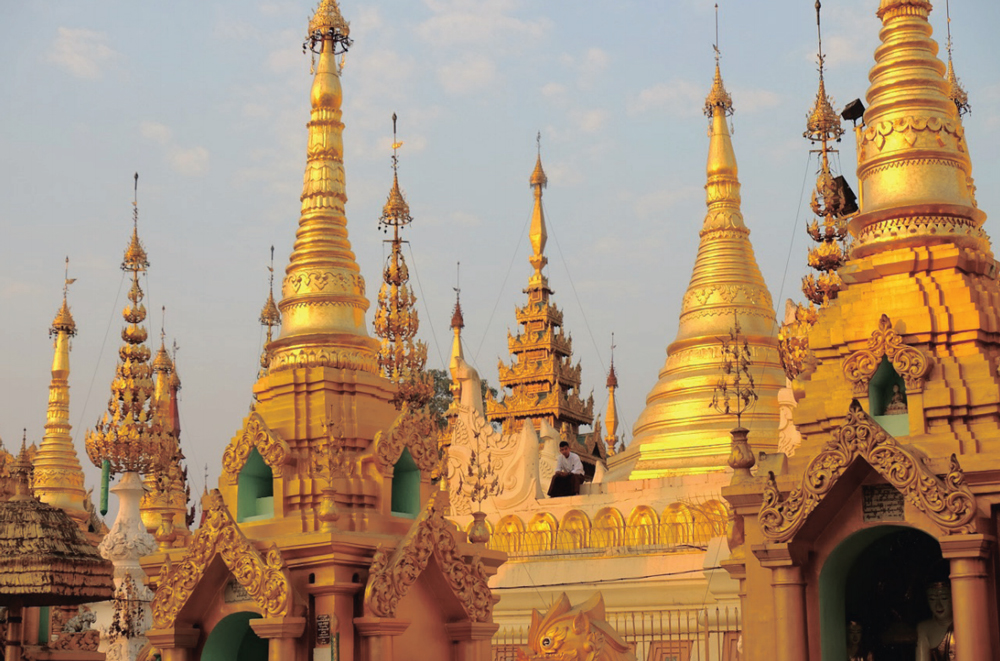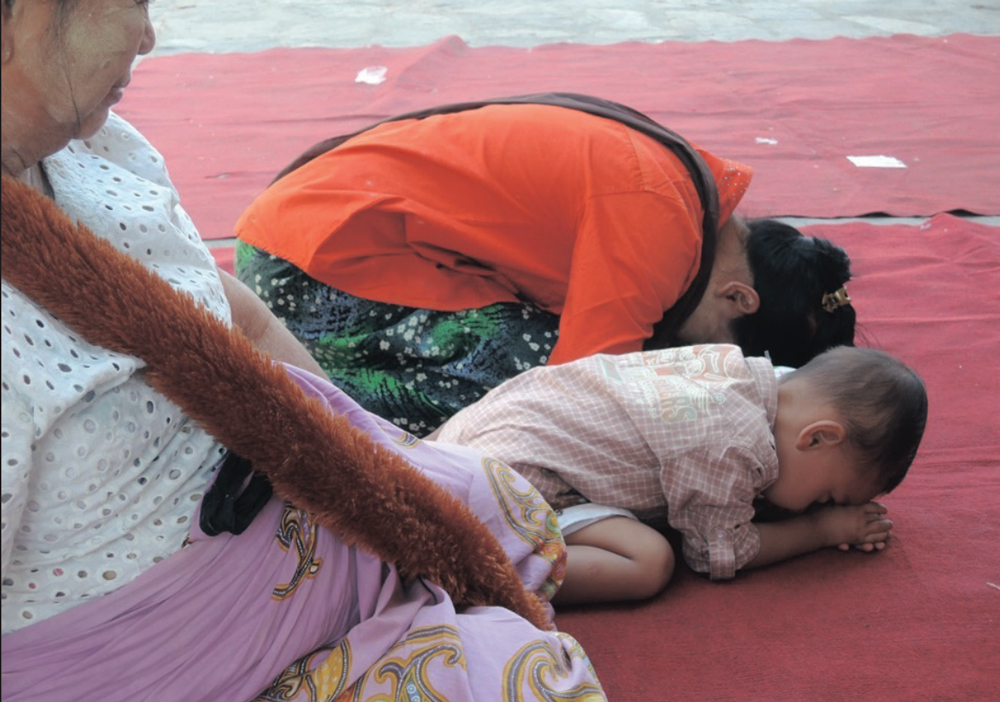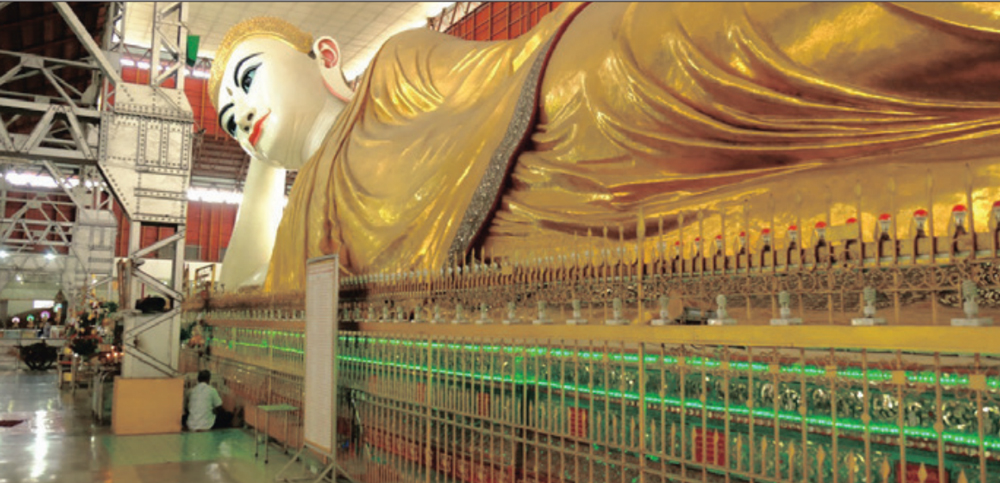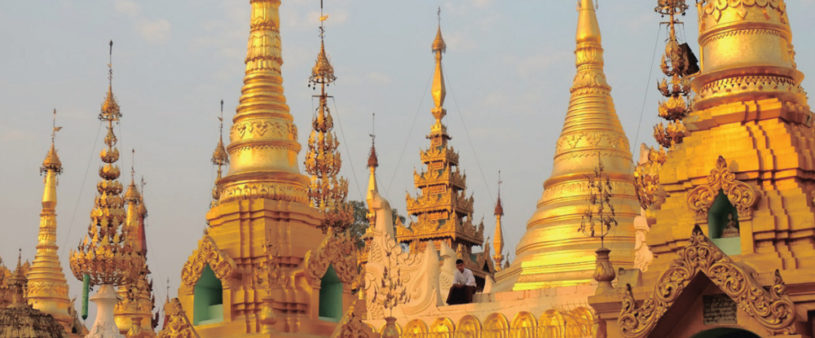MYANMAR has the most Buddhist temples of any South-East Asian country.
There are said to be a million pagodas and stupas! In the rural village of Bagan alone, there are over 3000 structures on a plain of 42km2, the site of the first Burmese kingdom between the 11th and 13th centuries.
In each city, town and remote village, there are pagodas to be found.
Fascinatingly, although hundreds are now in ruins, countless are still places of active worship and the centre of community life. In addition, hundreds of Buddhist temples are being built, to add to the existing vast numbers. I saw new construction – with bamboo scaffolding – as well as restoration, in each place I visited.
Donating money to build a pagoda on temple grounds, or to support a monastery, is one of the most popular ways to earn merit (kutho), believed to allay illness and misfortune and secure a better rebirth in the next life. The wide practice of Theravada Buddhism in Myanmar permeates the daily life of the people, ranking them as the world’s most generous country, along with the US. I experienced the renowned hospitality when I was invited off the street into a private home in again to enjoy a magnificent meal with an extended family.
Exploring some of the major temples and their nearby monasteries, observing the vibrant and bustling activity, is a major attraction of Myanmar. When you enter a temple, whether it is famous like Shwedagon Paya in Yangon, Mahamuni Payi in Mandalay or a small one you discover near your hotel at Inle Lake, you will be required to take off your shoes. Women and children will approach you selling fresh cut flowers, fruit or incense, which are placed at the shrines as an offering.
Once you are inside the temple, expect numerous images of Buddha. Sometimes a huge statue dominates in each of the four compass points. Aspects of the life of Buddha are shown in various ways using sculpture and paintings.
Some temples sell gold leaf, which is pressed on to certain statues as an act of worship. In some places the gold is so thick that the Buddha effigy becomes an amorphous mass.
In the Maha Myat Muni Pagoda, in Mandalay, women are not permitted to apply the gold leaf. The Buddha-graven images frequently have brightly coloured and flashing lights above them. Sometimes pillars are also entwined with these pulsating lights.
The devotion and sincerity of the worshippers is touching. As you are not allowed to point your foot at a Buddha image, people tend to either sit on their knees or cross-legged as they meditate or pray. In one temple I saw a tiny toddler copying her mother, who was bowing down.

STRIKING: Gilded turrets of the magnificent Schwedagon Pagoda in Yangon – Pictures: GILLIAN MCLAREN
Outside the temple there is a sizeable bell, which you can ring using a thick wooden stick. This is a symbol of Buddha’s voice, calling for the protection of deities and sustaining the order of things in the universe. Children love to sound the bells and gongs and vie to see who can make the loudest sound. Stray dogs and cats wander in and out of the temples, seeking food and shade.
Faith and superstition go hand-in-hand in Myanmar. I saw vans selling lotto tickets outside the temples, with individuals carefully considering which ticket to choose. People still consult astrologers to find a marriage partner or an auspicious date for a major life event. In private homes I visited, personal shrines to Buddha included spirit houses for “nat”, or spirit beings. Tree spirit shrines can be seen on venerated Banyan trees, which symbolise Buddha’s enlight-enment.

FAMILY PRAY : A toddler copies her mom in Mandalay
People of all ages can spend an unspecified time as a monk or nun. In the early mornings, members of he Sangha walk in the streets with their bowl (formerly known as a begging bowl, but now as an offering bowl) wearing their robes. Men are clad in saffron and women in pink. Restaurant owners, or any lay people come out on to the streets with pots of rice – or if the Sanga is lucky maybe some curry – which they ladle into the bowls.
Giving food to the monks and nuns is done willingly as an offering, as unto Buddha and is considered a righteous act that creates positive karma.
Feeding birds is another way of making an offering, so birdseed is sold and thrown to the pigeons.

REVERED: Reclining Buddha Temple in Yangon
Now is the time to visit this fascinating country, which was one of the most isolated in the world, but opened to the West – and to the thought of democracy – in 2011.
Be surprised and delighted by tradition where all the men wear sarong-like longhis, women and children paint their faces with tha-naka made from bark, old men and woman savour cheroots or chew on bright red betel nut and tea houses are almost as abundant as temples.
Places to stay
- The Strand Yangon, set in the vibrant old city, surrounded by grand colonial-period buildings, is recently refurbished, but still steeped in tradition from the colonial era, with delicious high teas and fine-dining, whirring ceiling fans, a smoking bar and butler to unpack your clothes. See hotelthestrand.com
- Blue Bird Hotel Bagan, in a verdant garden, with swimming pool and al fresco restaurant, is an oasis, on a dust road in a village which is a walking distance from some of the extraordinary temples of Bagan. Local people are employed and sound eco-friendly principles are practised here. See bluebirdhotelbagan.com
- Hotel by the Red Canal, Mandalay, is a boutique hotel in a welcoming space enclosing a lush garden with water features. It has a striking pagoda-style roof, red teak furniture and lavish amenities. See hotelredcanal.com
- The Strand Cruise is the perfect way to get from Bagan to Mandalay in pure luxury, enjoying excellent food, exploring fabulous temples and local life along the Ayeyarwady river, with musical and puppet shows by local artists, plus demonstrations on how to wear a longhi and facial thanaka paste. See thestrandcruise.com
- Sanctum Inle Resort is tranquil and elegant, with high ceilings and selected teak furniture, set in a large garden including tamarind trees, with views over an infinity swimming pool to paddy fields and the Inle Lake, with the Shan mountains. It is well sited for taking day boat trips to water villages. See sanctum-inle-resort.com
How to get there
Cathay Pacific, measured as the world’s safest airline for the last three years, has a business class cabin that is spacious, open and decorated in soothing tones.
Having an ergonomically designed flat bed, the longest and widest of any commercial airline, I slept soundly.
Generous storage space, intuitive seat and entertainment system controls, fabulous food and wine served by efficient staff made this an exceptionally comfortable and enjoyable long-haul option.
Well worth the extra cost, Cathay Pacific Premium Economy seats in a quiet, roomy separate cabin are bigger, wider and have a pitch of 15cm more than economy class. I appreciated the large meal table, cocktail table, 27cm personal television and added space to stow my cameras.
The welcome champagne did not go amiss, nor did the personal water bottle and extra snacks. Five kilograms of extra luggage and priority check-in and boarding are a boon. I highly recommend this choice.







